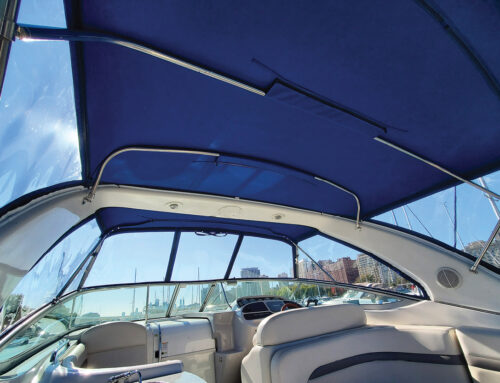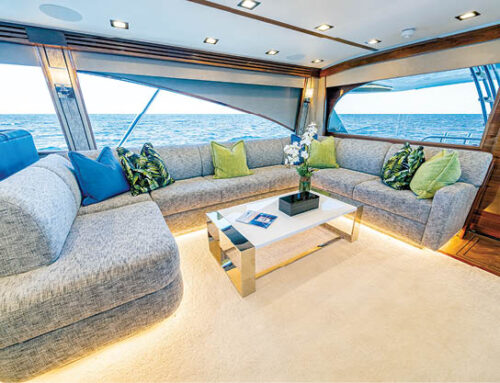Well-defended exterior upholstery

Marine-grade vinyl is the standard choice for exterior cushions and seating, thanks to its versatility in the face of a punishing environment.
Fabrics and components that result in long-lasting cushions
Exterior boat cushions get punished. They withstand the sun, wind, rain, saltwater, temperature changes and passenger activity. Despite these factors, these cushions are expected to look good while exposed to climate conditions. Fortunately, marine fabricators know how to merge form and function in outdoor seating. “We must spend time making patterns, getting corners to fit perfectly, accounting for bevels and other shapes, selecting fabrics based on durability ratings and educating the customer about the best choices for their project,” says Krisha Plauché, principal designer for Onboard Interiors LLC in Marblehead, Mass.
From bow to stern, exterior boat seating comes in many forms: helm chairs, rail seats, cockpit cushions, gunnel pads, tower cushions and leaning posts, sun pads, backrests and pillows. Although seating that is regularly exposed to the elements will eventually wear down, material selection suitable to the boat’s usage and storage can prolong the life of outdoor cushions.
Functional, fashionable fabric
Marine-grade vinyl remains the go-to fabric choice for many types of exterior cushions. That’s because the material repels water, deters some growth of mold and mildew, and resists UV rays. Linda Beach, owner of Beach Upholstery LLC in Virginia Beach, Va., keeps a variety of colors and styles of Seaquest vinyl in stock at all times. She describes it as “a good quality marine vinyl with a moderate price point.”
Beach notes that the material aligns well with the types of boats in her market. “There are hundreds of charter and fishing boats and a wide array of leisure craft, and we have found this product to wear well, maintain its color-fastness and provide ease of cleaning,” she says.
Beach also reports rising popularity of higher-end vinyls.
She says that customers like the soft leather-like feel of Ultraleather® and the variety of colors and textures it offers, while Edge from Morbern comes in vibrant colors with slight texturing.
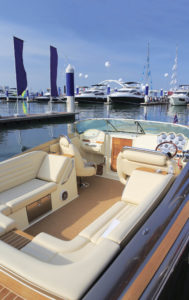
Marine fabricators merge form and function to create exterior boat cushions that look good and perform well despite constant exposure to harsh elements.
“These products are offered at a higher price point, but the customers that select these products are making a long-term investment in quality, comfort and aesthetics,” Beach says.
For its many advantages, marine-grade vinyl has its drawbacks, too. “If the vinyl gets soaked enough, it’s eventually going to absorb water,” says Rick Hirsch of Manart-Hirsch Co. Inc. in Lynbrook, N.Y. “Dirt will adhere to it, and mold and mildew adheres to dirt.”
To prolong the life of vinyl that isn’t protected by enclosures, boat covers or bimini tops, fabricators will make cushion covers out of solution-dyed acrylic like Sunbrella®. “The material is more breathable and more comfortable than vinyl,” says Robert Burkart, owner of Sewline Upholstery Ltd., Medicine Hat, Alberta, Canada. “You don’t sweat when you sit on the hot seat, and it still resists water. The foam won’t get moldy either.”
Burkart has started to use TOP NOTCH® solution-dyed polyester, because the fabric is lightweight, water repellent, mildew resistant, exceptionally colorfast and stronger than its acrylic counterparts. Whether acrylic or polyester, solution-dyed fabric will not deteriorate in the sun.
Storage conditions
Just as a boat’s usage will influence exterior upholstery choices, so, too, does its storage conditions. “You take a look at any marina and most folks just leave their exterior cushions uncovered,” Hirsch says. “Eventually the vinyl does deteriorate. The sun dries it out, and the vinyl will get hard and brown.”
Conversely, Burkart says, “People don’t always let their boats dry out properly and just throw a tarp over the top.” The result: Moisture can penetrate the seats and cause the growth of mold and mildew.
No matter the location, where a boat is stored is equally important as how it’s stored. “Sometimes boats are kept underneath trees that shoot off little sap buds, and they leave a yellow stain that can’t be removed,” says Burkart. “It will often require a recover, but a lot of people don’t want to spend the money. So they’ll get a mobile vinyl covering they can dye or respray.”
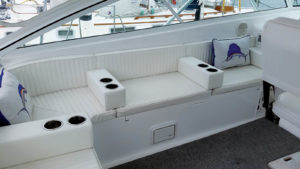
Drink holders made from the same vinyl as exterior cushions add a touch of convenience and customization. Credit: Beach Upholstery
Durable components and thread
A responsible fabricator specifies not only the proper fabric for exterior cushions, but the components that seal and fasten them as well. When it comes to fasteners, Hirsch recommends stainless steel whenever possible. If a component isn’t available in stainless steel, nickel-on-brass is the next logical choice. Plastic is also suitable for certain components and applications. For the inboards and outboards he frequently works on, Burkart uses VISLON® injected-plastic zippers from YKK to close exterior cushions. Available in about a dozen color variations, the zippers do not experience problems with moisture.
Plauché has recently begun using a plastic adhesive snap component called SNAD®. “SNADs have an adhesive backing so you can install them easily and they don’t ruin deck or fiberglass,” she says. “We recently used these when a new teak deck was installed to fit seats.”
In addition to easy installation, the SNAD product won’t deteriorate from exposure to sunlight, sand or dirt. “It will never corrode, and you don’t have to drill holes, which is good if a customer doesn’t want to use a screw in a specific area of the boat,” Hirsch says.
Fabricators must also rely on a robust thread. While a blended polyester is standard for exterior cushions, many marine upholstery suppliers and shops have been sewing with PTFE (polytetrafluoroethylene) thread—in particular, GORE® TENARA®.
UV resistance is built into TENARA, made from fluoropolymer fiber. It also is chemically inert, withstands extreme temperatures and resists precipitation of all kinds. “PTFE threads don’t pull apart,” Hirsch says. “They are phenomenal for longevity.”
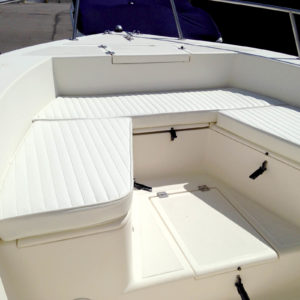
When crafting exterior cushions, fabricators try to match the style and usage of the boat. Credit: Beach Upholstery
Foam solutions
Inside the cushion, fabricators have access to several different types of foams. The most popular for exterior boat cushions is #1845 and #1850 standard foam rubber, according to Hirsch. His company also sells high-density polyurethane foam. “It’s a little harder and not as comfortable to sit on, but it’s impervious to water,” he says.
Meanwhile, Beach Upholstery uses a closed-cell foam called Celex, which many local fishing boat owners request for tower cushions and leaning posts. The shop typically uses thicknesses of 2–3 inches for a cushion and 1¼–2 inches for backrests, depending on design.
“Interestingly, Celex can be used as a floatation device and it doesn’t shrink in extreme weather like other closed-cell foam,” Beach says.
That extra nautical mile
Care and maintenance go a long way in extending the life of an exterior cushion. Among the tips Beach provides her customers: Never use Armor All™, whose oil base will cause irreparable harm to the vinyl. If using sun lotion, always put a towel down on the vinyl before sitting. Magic Erasers live up to their name, taking out almost any stain. Above all, cover the boat when not in use.
What’s more, creating one-of-a-kind touches can help forge long-term relationships, so when it is time to replace or repair an exterior cushion, the customer knows where to go. “We offer our customers a custom drink holder covered in the same vinyl as the cushions,” Beach says. “This item is very popular with local leisure craft owners.”
For her part, Plauché of Onboard Interiors provides customers with blankets woven with Sunbrella thread. “They are so durable and yet so comfortable, and a perfect item to add for interior and exterior upholstery projects,” she says. “Customers often order more than one.”
Holly O’Dell is a freelance writer and editor based in Joshua Tree, Calif.
 TEXTILES.ORG
TEXTILES.ORG 




